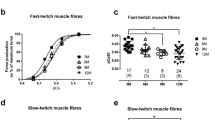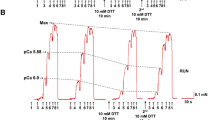Abstract
The purpose of the present study was to examine the effects of aging, inactivity and weight-bearing exercise on fast-twitch single Type IIB skeletal muscle fibers from the superficial region of the lateral head of the gastrocnemius (Type IIB fibers). Specifically, this study compared the biochemical properties of Type IIB fibers after 7 days of hindlimb unweighting (HU), 7 days of HU with intermittent weight-bearing (HU-Ex), and cage control (C) from adult and aged Fischer 344 Brown Norway F1 Hybrid rats (12- and 30-month old). Biochemical measurements included total lactate dehydrogenase (LDH) and β-hydroxy-acyl-coenzyme A dehydrogenase activities (BHAD), expressed in nmoles/μg/hr dry weight. Fiber-typing for myosin heavy chain isoform was determined by SDS-PAGE. With age, LDH activity in Type IIB fibers decreased from 52.0±3.4 nmoles/μg/hr (12-month old) to 39.5±2.9 nmoles/μg/hr (30-month old). Following HU, LDH activity of single Type IIB fibers increased by 22% (52.0±3.4 to 66.4±3.2 nmoles/μg/hr) in the 12-month-old animals, whereas no difference was observed with HU in the Type IIB fibers of the 30-month-old animals. Following HU-Ex, LDH activity of Type IIB fibers in the 12-month-old animals was not significantly different from that of Type IIB fibers from HU animals, whereas a significant increase was observed (38.1±2.9 to 51.8±3.1 nmoles/μg/hr) in Type IIB fibers of 30-month-old animals, for HU and HU-Ex, respectively. Analysis of variance revealed an interaction between age and condition, indicating that Type IIB fibers from adult and aged animals have a different biochemical response to inactivity. The enzyme activities for BHAD were not different between the experimental conditions. The results demonstrate that the total LDH enzyme activities of the Type IIB fibers decrease with age, suggesting an age-related shift in the biochemical profile. Further, single skeletal muscle fiber adaptation is age-dependent.
Similar content being viewed by others
References
Larsson L, Ansved T. Effects of aging on the motor unit. Prog Neurobiol 1995; 45: 397–458.
Thompson LV. Effects of age and training on skeletal muscle physiology and performance. Phys Ther 1994; 74: 71–81.
Thompson LV, Johnson SA, Shoeman JA. Single soleus muscle fiber function after hindlimb unweighting in adult and aged rats. J Appl Physiol 1998; 84: 1937–42.
Essen-Gustavsson B, Borges O. Histochemical and metabolic characteristics of human skeletal muscle in relation to age. Acta Physiol Scand 1986; 126: 107–14.
Fiatarone MA, Marks EC, Ryan ND, Meredith CN, Lipsitz LA, Evans WJ. High intensity strength training in nonagenarians. Effects on skeletal muscle. JAMA 1990; 263: 3029–34.
Frontera WR, Meredith CN, O’Reilly KP, Knuttgen HG, Evans WJ. Strength conditioning in older men: skeletal muscle hypertrophy and improved function. J Appl Physiol 1988; 64: 1038–44.
Grimby G, Aniansson A, Zetterberg C, Saltin B. Is there a change in relative muscle fiber composition with age? Clin Physiol 1983; 3: 209–18.
Larsson L, Sjodin B, Karlsson J. Histochemical and biochemical changes in human skeletal muscle with age in sedentary males age 22–65 years. Acta Physiol Scand 1978; 103: 32–9.
Thompson LV, Shoeman JA. Contractile function of single muscle fibers after hindlimb unweighting in aged rats. J Appl Physiol 1998; 84: 229–35.
Caccia MC, Harris JB, Johnson M.A. Morphology and physiology of skeletal muscle in aging rodents. Muscle Nerve 1979; 2: 202–12.
Pettigrew FP, Gardiner PF. Changes in rat plantaris motor unit profiles with advanced age. Mech Aging Dev 1987; 40: 243–59.
Fitts RH, Brimmer C, Heywood-Cooksey A, Timmerman R. Single muscle fiber enzyme shifts with hindlimb suspension and immobilization. Am J Physiol 1989; 256: C1082–91.
Grimby G, Danneskiold-Samsoe B, Hvid K, Saltin B. Morphology and enzymatic capacity in arm and leg muscles in 78–81 year old men and women. Acta Physiol Scand 1982; 115: 125–34.
Passonneau JV, Lowry OH. Pyridine nucleotides. Enzymatic analysis: a practical guide. The Human Press Inc. 1993.
Coggan AR, Spina RJ, King DS, et al. Histochemical and enzymatic comparison of the gastrocnemius muscle of young and elderly men and women. J Gerontol 1992; 47: B71–6.
Pettigrew F, Noble E. Shifts in rat plantaris motor unit characteristics with aging and compensatory overload. J Appl Physiol 1991; 71: 2363–8.
Simard C, LaCaille M, Vallieres J. Enzymatic adaptations to suspension, hypokinesia in skeletal muscle of young and old rats. Mech Aging Dev 1985; 33: 1–9.
Simard C, LaCaille M, Vallieres J. Effect of hypokinesia/hypodynamia on contractile and histochemical properties of young and old rat soleus muscle. Exp Neurol 1987; 97: 106–14.
Stump C, Tipton C, Henriksen E. Muscle adaptations to HU in mature and old Fischer 344 rats. J Appl Physiol 1997; 82: 1875–81.
Alley KA, Thompson LV. Influence of simulated bedrest and intermittent weight-bearing on single skeletal muscle fiber function in aged rats. Arch Phys Med Rehabil 1997; 78: 19–25.
Herbert ME, Roy RR, Edgerton VR. Influence of one week hindlimb suspension and intermittent high load exercise on rat muscles. Exp Neurol 1988; 102: 190–8.
Jaspers SR, Tischler ME. Atrophy and growth failure of rat hindlimb muscles in serial-cast suspension. J Appl Physiol 1984; 57: 1472–9.
Sandmann M, Shoeman J, Thompson LV. The fiber-type specific effect of inactivity and intermittent weight-bearing on the gastrocnemius muscle of an aged animal population. Arch Phys Med Rehabil 1998; 79: 658–62.
Lipman RD, Chrisp CE, Hazzard DG, Bronson RT. Pathologic characterization of brown Norway, brown Norway × Fischer 344. and Fischer 344 × brown Norway rats with relation to age. J Gerontol 1996; 51A: B54–9.
Hintz CS, Lowry CV, Kaiser KK, McKee D, Lowry OH. Enzyme levels in individual rat muscle fibers. Am J Physiol 1980; 239: C58–65.
Lexell J, Taylor C, Sjostrom M. What is the cause of the aging atrophy? Total number, size and proportion of different fiber types in whole vastus lateralis muscle from 15–83 year old men. J Neuro Sci 1988; 84: 275–94.
Sato T, Akatsuka J, Kuniyoshi K, Tokoro Y. Age changes in size and number of muscle fibers in human minor pectoral muscle. Mech Aging Dev 1984; 28: 99–109.
Larsson L, Karlsson J. Isometric and dynamic endurance as a function of age and skeletal muscle characteristics. Acta Physiol Scand 1978; 104: 129–36.
Thompson LV, Lowe DA, Ferrington DA, Thomas DD. Electron paramagnetic resonance: a high-resolution tool for muscle physiology. Exerc Sport Sci Rev 2001; 29: 3–6.
Gulve E, Rodnick K, Henriksen E, Holloszy J.O. Effects of wheel running on glucose transporter (GLUT-4) concentration in skeletal muscle of young adult and old rats. Mech Aging Dev 1993; 67: 187–200.
Kern M, Dolan P, Mazzeo R, Wells J, Dohm G. Effects of aging and exercise on GLUT-4 glucose transporters in muscle. Am J Physiol 1992; 263: E362-7.
Author information
Authors and Affiliations
Corresponding author
Rights and permissions
About this article
Cite this article
Groskreutz, J.J., Thompson, L.V. Enzymatic alterations in single Type IIB skeletal muscle fibers with inactivity and exercise in 12- and 30-month-old rats. Aging Clin Exp Res 14, 347–353 (2002). https://doi.org/10.1007/BF03324461
Received:
Accepted:
Published:
Issue Date:
DOI: https://doi.org/10.1007/BF03324461




